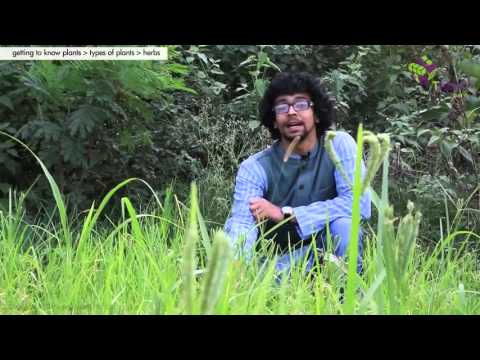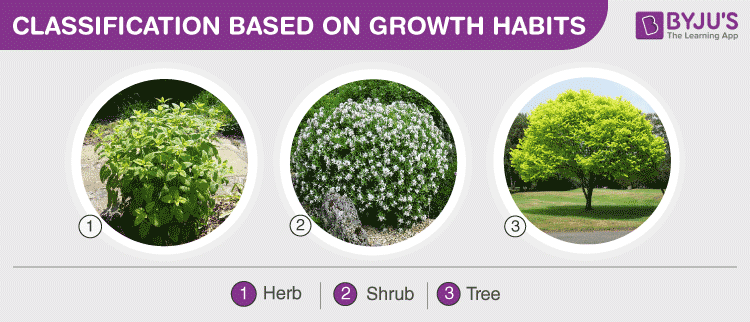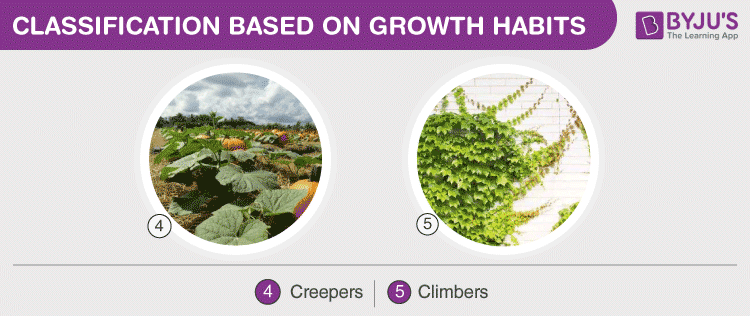We see a huge variety of plants all around us. Among which few are terrestrial and aquatic plants. Despite this fact, they all have the same parts and the same functions; they appear unique with different types of roots, stems, leaves, flowers, fruits, seeds etc. Therefore, the classification of plants is mainly based on several factors, and they can be further classified based on their height, tenderness of stem, branches and their life cycle.
In this article, let us know in detail about the classification of Plants based on Growing Habits. Before that, let us define the term “Growth Habit.”

Table of Contents

What is Growth Habit?
In horticulture, the term growth habits refer to the plant’s growth and its development or change in the plant’s height, shape and the kind of growth it undergoes. There are genetic factors as well as environmental factors which play an important role in their growth habit.
For instance, interaction with various animals influences the way plants adapt to their environment. From an evolutionary perspective, growth habits have the function of ensuring the survival and adaptation of plants in various habitats, consequently increasing the chances of successfully passing on the genes to the next generation.
Classification Based on Growth Habits
If we consider plants, based on their height, some are too short while some are too tall to climb. Besides the height, stem thickness and delicacy also varies.
For example– Short plants have greenish, soft, and tender stems, while big and tall plants or trees have a thick, strong and woody stems which are hard to break.
Explore more: Classification of Plants
Based on the growth habit, plants are broadly categorised into three groups:

Herbs, Shrubs and Trees
Herbs
Herbs are short-sized plants with soft, green, delicate stems without woody tissues. They complete their life cycle within one or two seasons. Generally, they have few branches or are branchless. These can be easily uprooted from the soil. Herbs contain enough nutritional benefits, including vitamins and minerals, to make them a part of a healthy balanced diet. Tomato, wheat, paddy, grass and bananas are a few examples of herbs.
Explore more: Herbs and their Benefits
Shrubs
Shrubs are medium-sized, woody plants taller than herbs and shorter than a tree. Their height usually ranges from 6m to 10m tall. Their features include bushy, hard, and woody stems with many branches. Although stems are hard, they are flexible but not fragile. The lifespan of these plants usually depends on the species. Rose, jasmine, lemon, tulsi, and henna are some of the common shrubs around us.
Explore more: Shrubs and their Uses
Trees
Trees are big and tall plants. They have very thick, woody and hard stems called the trunk. This single main stem or the trunk gives rise to many branches that bear leaves, flowers and fruits. Some trees are branchless like coconut trees; i.e., they have only one main stem which bears leaves, flowers, and fruits all by itself. The lifespan of a tree is very long. i.e., for several years. Banyan, mango, neem, cashew, teak and oak are some examples of trees.
In addition to these three categories of plants, there are two more types which need some support to grow. They are specifically called climbers and creepers.

Climbers
Climbers are much more advanced than creepers. Climbers have a very thin, long and weak stem which cannot stand upright, but they can use external support to grow vertically and carry their weight. These types of plants use special structures called tendrils to climb. A few climbers’ plant names include pea plant, grapevine, sweet gourd, money plant, jasmine, runner beans, green peas, etc.
Creepers
Creepers, as the name suggests, are plants that creep on the ground. They have very fragile, long, thin stems that can neither stand erect nor support all their weight. Examples include watermelon, strawberry, pumpkin and sweet potatoes.
Also Read: Photosynthesis Process
Learn more about Plants, their types, importance and other related topics at BYJU’S Biology
Frequently Asked Questions
How do herbs differ from shrubs?
Briefly explain the classification of plants.
What is meant by Growth habit?
State five examples of shrubs.
What are the characteristics of herbs?
The characteristics of herbs are:
- They are small plants with soft and delicate stems.
- They have a green, tender, soft and delicate stem.
- They have a short lifespan and can live only for one or two seasons.
- They are shorter in size, and they may grow between 2 to 3 meters tall.
What are climbers?
Provide a few examples of climbers.
Provide a few examples of creepers.
What are creepers?
How are climbers different from creepers?
Creepers spread their stem, leaves horizontally along with the soil on the ground and also bear flowers along with the fruits on the ground. The leaves of the creepers produce fibre-like roots which fix the plant to the ground and provide external support to grow further.
Climbers are plants with a tender stem which grow with the help of external support. These plants produce a twine or hook from their leaves to climb. Some plants produce special roots that serve as the holdfasts to climb around certain objects.

Potato carrot radish onion garlic ginger is which type of plants?
Potato is an annual plant. Onion and carrot are biennial plants. Radish is annual and biennial. Ginger and garlic are perennial.
what plants would be a good example to talk about their life cycle
The lifecycle of tomatoes or sunflowers would make an easy and interesting example to talk about. However, any plant would make a good example as long as you are able to identify the type.
what is biennial and perennial
A biennial plant takes two years to complete its lifecycle. In the first year, only the roots, leaves and stem grows. In the second year, flowers are formed, seeds are produced and they eventually die
A perennial plant is a plant that lives for more than two years. Moreover, the plants produce flowers every year. The stem of perennial plants usually die in winters, but since the roots do not die, they regenerate the following year.
I understand more things from the video
Is banana a shrub?
Banana is technically a herb because it lacks the characteristic woody stem of shrubs (and trees).
Thanks it was really very helpful for me to understand more things.
banana is a herb
Is Tulsi a shurb or herb ?
Tulsi is a shrub
Mushroom is a Herb or Shrub ?
Mushroom is a fungus.
Differences between herbs, shrubs and trees.
Based on the size and pattern of branching, plants can be categorized into herbs, shrubs, and trees. The differentiating factor between the three is that herbs have unbranched, soft, and non-lignified stems (Ex: Banana). Shrubs exhibit multi stems that are woody and branched immediately (Ex: Rose). Trees, on the other hand, exhibit a woody stem shooting upwards for close to one meter before they show branching. They are the tallest plants (Ex: Mango).
What are characteristics of trees?
Trees are tall plants. These big plants exhibit woody, thick, and hard stems(trunk) which in turn gives rise to several branches. Branches bear leaves, fruits, and flowers. They are perennial plants possessing trunks that contain woody tissues providing mechanical strength and the vascular tissues carrying substances from one to the other part. Typically, they reproduce through seeds. Trees eliminate carbon dioxide and enrich the atmosphere with oxygen, vital for existence.
Segregate plant according to thorns, climbers and creepers.
difference between shrubs,herbs,climbers,creepers.
More example of creepers
is green gram
herb/shrub/climbers/creeper/trees?
Money plant is climber or creeper ?
they are also weak stem they also creep along the ground
Money plant is a climber
what type of plant for liverwort?
Liverworts are bryophytes, they are non-vascular plants similar to mosses, e.g. Marchantia.
It is very helpful as it helps me a lot in method of online learning.